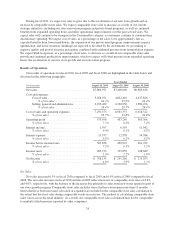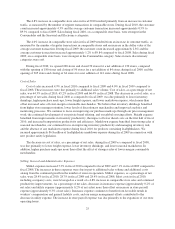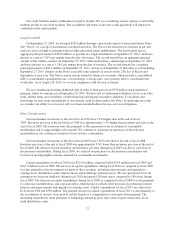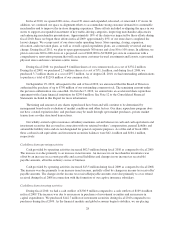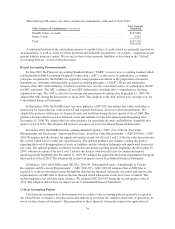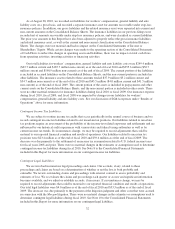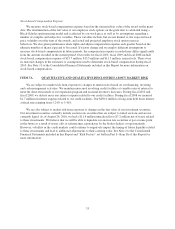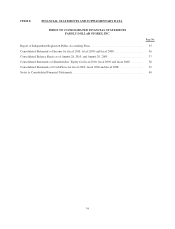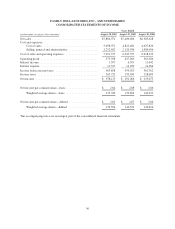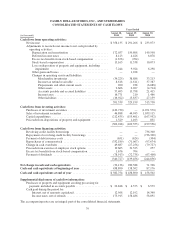Family Dollar 2010 Annual Report Download - page 35
Download and view the complete annual report
Please find page 35 of the 2010 Family Dollar annual report below. You can navigate through the pages in the report by either clicking on the pages listed below, or by using the keyword search tool below to find specific information within the annual report.accounting policies in addition to certain estimates and judgments by our management. Our estimates and
judgments are based on currently available information, historical results and other assumptions we believe are
reasonable. Actual results could differ from these estimates.
We believe the following accounting principles are critical because they involve significant judgments,
assumptions and estimates used in the preparation of our Consolidated Financial Statements.
Merchandise Inventories:
Our inventories are valued using the retail method, based on retail prices less mark-on percentages, which
approximates the lower of first-in, first-out (FIFO) cost or market. We record adjustments to inventory through
cost of goods sold when retail price reductions, or markdowns, are taken against on-hand inventory. In addition,
we make estimates and judgments regarding, among other things, initial markups, markdowns, future demand for
specific product categories and market conditions, all of which can significantly impact inventory valuation.
These estimates and judgments are based on the application of a consistent methodology each period. While we
believe that we have sufficient current and historical knowledge to record reasonable estimates for these
components, if actual demand or market conditions are different than our projections, it is possible that actual
results could differ from recorded estimates. This risk is generally higher for seasonal merchandise than for
non-seasonal merchandise. We estimate inventory losses for damaged, lost or stolen inventory (inventory
shrinkage) for the period from the most recent physical inventory to the financial statement date. The accrual for
estimated inventory shrinkage was $49.5 million as of the end of fiscal 2010 and $56.2 million as of the end of
fiscal 2009. The accrual for estimated inventory shrinkage is based on the trailing twelve-month actual inventory
shrinkage rate and can fluctuate from period to period based on the timing of the physical inventory counts.
Stores receive a physical inventory at least annually. There were no material changes in the estimates or
assumptions related to the valuation of inventory during fiscal 2010.
Property and Equipment:
We state property and equipment at cost. We calculate depreciation for financial reporting purposes using
the straight-line method over the estimated useful lives of the related assets. For leasehold improvements, this
depreciation is over the shorter of the term of the related lease (generally five or ten years) or the asset’s useful
economic life. The valuation and classification of these assets and the assignment of useful depreciable lives
involves significant judgments and the use of estimates. We generally do not assign salvage value to property and
equipment. We review property and equipment for impairment whenever events or changes in circumstances
indicate that the carrying amount of an asset may not be recoverable. Historically, our impairment losses on fixed
assets, which typically relate to normal store closings, have not been material to our financial position and results
of operations. There were no material changes in the estimates or assumptions related to the valuation and
classification of property and equipment during fiscal 2010. See Notes 1 and 4 to the Consolidated Financial
Statements included in this Report for more information on property and equipment.
Insurance Liabilities:
We are primarily self-insured for health care, property loss, workers’ compensation, general liability, and
auto liability costs. These costs are significant primarily due to the large number of our retail locations and
employees. Our self-insurance liabilities are based on the total estimated costs of claims filed and estimates of
claims incurred but not reported, less amounts paid against such claims, and are not discounted. We review
current and historical claims data in developing our estimates. We also use information provided by outside
actuaries with respect to medical, workers’ compensation, general liability, and auto liability claims. The
insurance liabilities we record are mainly influenced by changes in payroll expense, sales, number of vehicles,
and the frequency and severity of claims. The estimates of more recent claims are more volatile and more likely
to change than older claims. If the underlying facts and circumstances of the claims change or the historical trend
is not indicative of future trends, then we may be required to record additional expense or a reduction in expense,
which could be material to our reported financial condition and results of operations.
31





